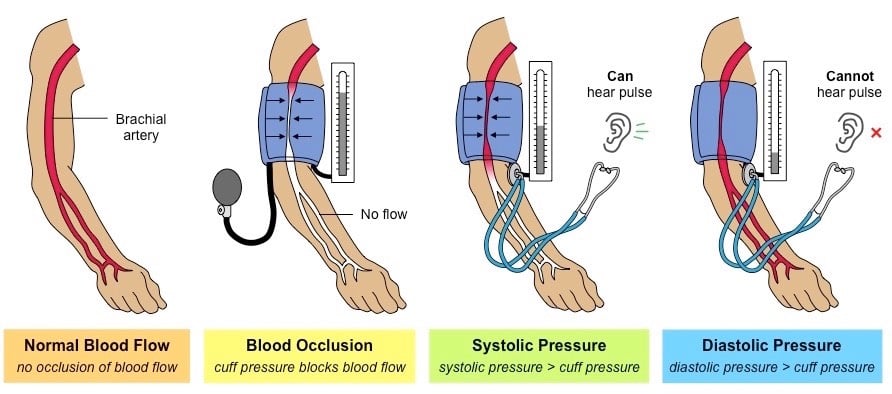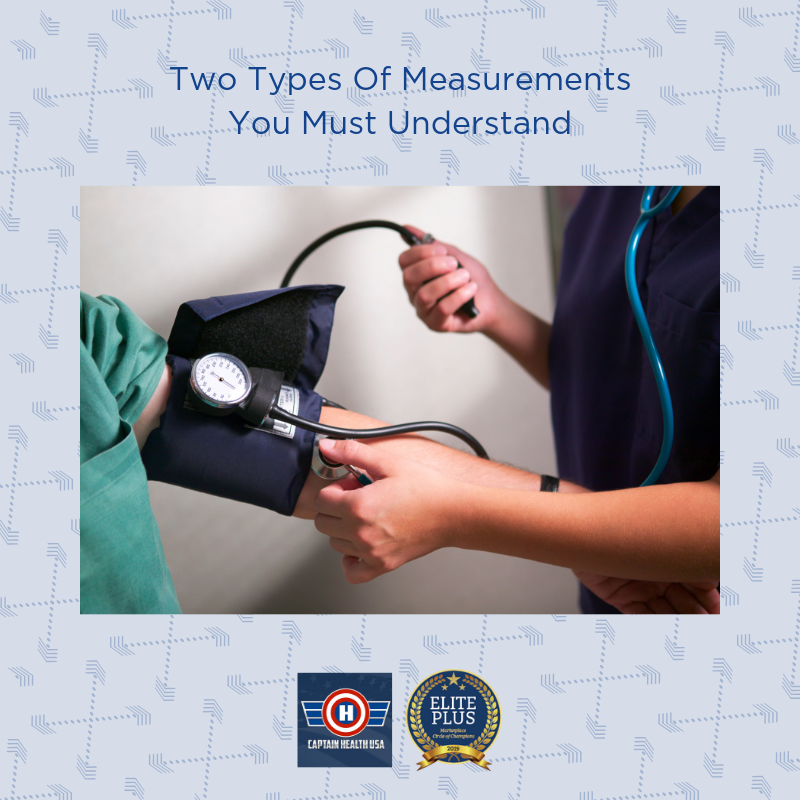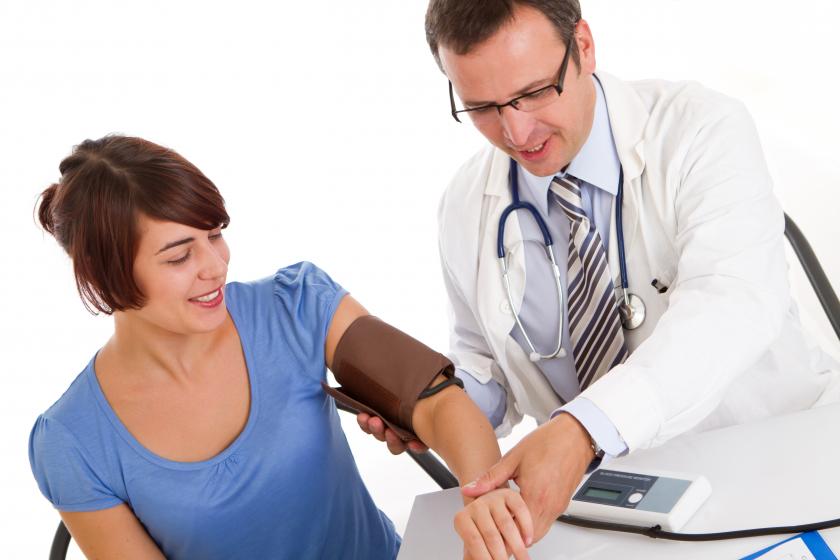Before You Measure Your Blood Pressure
- Avoid things that can raise your blood pressure in the short term. Dont measure your blood pressure within half an hour of eating, smoking, drinking caffeinated drinks such as coffee, or exercising. These can all raise your blood pressure temporarily. If you need to use the toilet, go before you measure your blood pressure.
- Wear loose-fitting clothes. Wear a short-sleeved t-shirt or something with sleeves you can push up easily, nothing tight. This is so that you can fit the cuff around your arm.
- Rest for five minutes before you take your reading. Sit down somewhere quiet, ideally at a desk or table. Have your back supported with your arm resting on a firm surface and your feet flat on the floor. Stay in this position while you take your blood pressure.
- Make sure your arm is supported and at the same level as your heart. Position yourself so that your arm is resting on a surface and is at the same height as your heart. Keep your arm and hand relaxed, not tensed.
- Make sure you are relaxed and comfortable. If you are anxious or uncomfortable, your blood pressure will rise temporarily.
When Should I Get My Blood Pressure Tested
You can ask for a blood pressure test if you’re worried about your blood pressure at any point.
You can get your blood pressure tested at a number of places, including:
- your local GP surgery
- at home
- at an NHS Health Check appointment offered to adults in England aged 40-74
It’s recommended that all adults over 40 years of age have their blood pressure tested at least every 5 years so any potential problems can be detected early.
If you’ve already been diagnosed with high or low blood pressure, or you’re at a particularly high risk of these problems, you may need to have more frequent tests to monitor your blood pressure.
How To Prepare For The Test
Before you measure your blood pressure:
- Rest for at least 5 minutes, 10 minutes is better, before blood pressure is taken.
- DO NOT take your blood pressure when you are under stress, have had caffeine or used tobacco in the past 30 minutes, or have exercised recently.
Take 2 or 3 readings at a sitting. Take the readings 1 minute apart. Remain seated. When checking your blood pressure on your own, note the time of the readings. Your provider may suggest that you do your readings at certain times of the day.
- You may want to take your blood pressure in the morning and at night for a week.
- This will give you at least 14 readings and will help your provider make decisions about your blood pressure treatment.
Recommended Reading: Onion And Blood Pressure
Questions To Ask Your Doctor
- Why do I need to monitor my blood pressure at home?
- How often do I need to measure my blood pressure?
- What type of monitor should I use?
- What do my blood pressure readings mean?
- What is considered a normal blood pressure for me?
- What should I do if my readings are abnormal?
- Are there any lifestyle changes I can make to help manage my blood pressure?
- Do I need to take medicine to manage my blood pressure?
- What other things can affect a blood pressure reading?
What Affects A Blood Pressure Reading

Many things can affect a blood pressure reading, including:
- Nervousness about having your blood pressure taken. This is called white coat syndrome. As many as 1 in 3 people who have a high blood pressure reading at the doctors office may have normal blood pressure readings outside of it.1
- What you ate, drank, or did before your reading. If you smoked, drank alcohol or caffeine, or exercised within 30 minutes of having your blood pressure measured, your reading might be higher.2
- How you are sitting. Crossing your legs and letting your arm droop at your side rather than rest on a table at chest height can make your blood pressure go up.2
Its important to get an accurate blood pressure reading so that you have a clearer picture of your risk for heart disease and stroke.
A reading that says your blood pressure is lower than it actually is may give you a false sense of security about your health. A reading that says your blood pressure is higher than it actually is may lead to treatment you dont need.
Also Check: Does Spicy Food Cause High Blood Pressure
Manual Blood Pressure Monitors
Manual models are like the ones that might be used in your doctor’s office. They usually include an arm cuff, a squeeze bulb to inflate the cuff, a stethoscope or microphone, and a gauge to measure the blood pressure.
To take your blood pressure, you inflate the cuff around your upper arm. This stops the flow of blood in the artery for a short time. You place the stethoscope on the skin over the artery. As you release air from the cuff, you listen for the sound of the blood as it starts to flow through the artery again.
The reading on the gauge when blood flow is first heard is the systolic pressure. The reading when blood flow can no longer be heard is the diastolic pressure.
Home Blood Pressure Monitoring
Blood pressure tests can also be carried out at home using your own digital blood pressure monitor.
This can give a better reflection of your blood pressure, as being tested in somewhere like a GP surgery can make you feel anxious and can affect the result. It can also allow you to monitor your condition more easily in the long term.
You can buy a variety of low-cost monitors so you can test your blood pressure at home or while you’re out and about.
It’s important to make sure you use equipment that has been properly tested. The British Hypertension Society has information about validated blood pressure monitors you can buy.
Don’t Miss: Omron Bp785 Calibration
Digital Blood Pressure Monitors
Digital blood pressure monitors are often used on the wrist, but they can also be placed on the finger or upper arm and are activated simply by pressing a button. They read the blood pressure automatically based on variations in the volume of blood in the arteries. When taking blood pressure measurements on the wrist, it’s important to keep the hand level with the heart. Otherwise it can affect the readings.
Digital meters can sometimes be inaccurate and produce unreliable readings anyway especially in people with certain heart rhythm problems or arteries that have hardened due to arteriosclerosis.
When To See The Doctor
The doctor should check your monitor at least once a year. This ensures that the measurements are accurate.
Only a doctor can diagnose you with high blood pressure. Contact your doctor if you have high readings for several days. Be sure to take your blood pressure log with you to the visit.
Hypotension is low blood pressure. This occurs when your systolic pressure is consistently below 90 or is 25 points below your normal reading. Contact your doctor if you have low readings. Hypotension can be a sign of shock, which is life threatening. Call your doctor right away if you are dizzy or lightheaded.
Also Check: Spicy Food High Blood Pressure
What Is Ambulatory Blood Pressure Monitoring
If a doctor recommends ambulatory blood pressure monitoring, you will need to wear a blood pressure cuff for 24 hours. It’s connected to a small, portable measuring device that automatically measures your blood pressure at set times and records the readings.
Ambulatory blood pressure monitoring is used, for example, to see whether blood pressure levels vary greatly over the course of the day and night or whether they are constantly elevated. During those 24 hours, you can do all of the usual things you would otherwise do over the course of the day. If you are especially active at certain times, you can make a note in a diary. Then the doctor has a better idea of how to interpret the recorded values when evaluating them.
How Is An Abnormal Map Treated
An abnormality in the MAP is generally a sign of some underlying problem affecting either the cardiac output or the systemic vascular resistance. This means that the treatment depends on which of these factors is not normal. The ultimate goal is to avoid end organ damage caused either by a MAP that is too low or a MAP that is too high.
A low MAP is dangerous because of underperfusion of the major organs. In order to bring up the pressure, IV fluids or blood transfusions can be given in order to increase the preload to the heart so it has more volume to eject. This will raise the cardiac output, which may increase the MAP. Vasopressors, which are medications that help to constrict the blood flow, can be given to increase the peripheral vascular resistance. In addition, many of these medications increase the heart rate as well, which will also serve to raise the cardiac output.
Treating a MAP that is too high is also important in order to reduce the risk of stroke and secondary heart failure. There are medications, like oral or IV nitroglycerin, which will relax the blood vessels so as to reduce the systemic vascular resistance quickly. The higher the MAP and the longer it is left unchecked, the greater is the chance for heart failure by a heart that cannot exert a force great enough to overcome the high arterial pressures.
Read Also: Onions And Blood Pressure
How Can High Blood Pressure Affect Pregnancy
If youre pregnant, high blood pressure can be dangerous for you and your baby. If you have high blood pressure and you want to get pregnant, its important to take steps to lower your blood pressure first.
Sometimes women get high blood pressure for the first time during pregnancy. This is called gestational hypertension. This type of high blood pressure usually goes away after the baby is born but you may have a higher risk of getting high blood pressure in the future.
If you have high blood pressure while youre pregnant, be sure to visit your doctor regularly. To learn more:
When Should I Check My Blood Pressure

A regular blood pressure check is the best way of monitoring blood pressure. You can request a blood pressure test from a GP or pharmacy, or take a reading at home using a blood pressure monitor.
If you have been diagnosed with high or low blood pressure, or have a higher risk of developing either it is advisable to check your blood pressure more frequently. It is recommended that adults over 40 should check their blood pressure at least every 5 years to detect any potential issues early.
This blood pressure checker is sourced from the NHS, all recommendations given by the blood pressure tool are supplied by the NHS website. Use the blood pressure checker as often as you wish.
You May Like: Do Onions Lower Blood Pressure
Choosing A Home Blood Pressure Monitor
The American Heart Association recommends an automatic, cuff-style, bicep monitor.
- Wrist and finger monitors are not recommended because they yield less reliable readings.
- Choose a monitor that has been validated. If you are unsure, ask your doctor or pharmacist for advice or find options at validatebp.org.
- When selecting a blood pressure monitor for a senior, pregnant woman or child, make sure it is validated for these conditions.
- Make sure the cuff fits measure around your upper arm and choose a monitor that comes with the correct size cuff.
Websites That Address The Map
Here are some websites that may help you further understand what the MAP is all about:
Read Also: Do Onions Lower Blood Pressure
What Affects The Map
There are several factors that determine the MAP, with the two main factors being the cardiac output and the resistance to blood flow. The cardiac output is the amount of blood per minute that is pumped out of the left ventricle of the heart. This number averages 5.25 liters per minute.
Anything decreasing the cardiac output will diminish the mean arterial pressure. This includes any cause of hypovolemia, including severe dehydration and trauma with significant blood loss. Heart failure or ventricular failure will decrease the ability of the heart to push blood through the body, reducing the cardiac output and the mean arterial pressure.
Because the cardiac output is the heart rate multiplied by the stroke volume, a rise in heart rate from an increased sympathetic tone in the body that is not accompanied by reductions in systemic vascular resistance can lead to an elevated MAP. Conversely, a reduction in heart rate by itself will reduce the cardiac output. Emotional stress alone will raise catecholamines in the body, increasing the heart rate and constricting the blood flow.
Fluid retention from kidney failure will increase the amount of fluid the heart must pump through the system and may increase the MAP. Kidney failure itself activates the renin-angiotensin-aldosterone system. This leads to chemical changes in the body that act to cause vasoconstriction and an increase in mean arterial pressure by increasing the vascular resistance.
How To Apply The Cuff Correctly
Upper arm blood pressure monitor
- CHECK.1Apply the cuff to bare skin or light innerwear
-
Wrap the cuff snuggly around the arm, on bare skin or light innerwear,making sure the cuff is securely in place. Remove heavy clothes such as a sweater before measurement, instead of rolling up the sleeves.
- CHECK.2Make the air tube run down the inside of your arm
-
Adjust the position of the air tube so that it runs down the inside of your arm and is positioned at the center of your arm.
- CHECK.3Cuff wrapping position
-
Position the cuff about 1-2cm above the bend of your elbow.Make sure that the cuff does not cover the joint region.
Wrist blood pressure monitor
-
Wrap the wrist cuff securely around your wrist. Do not apply the cuff over clothing.
- CHECK.2Wrap the cuff around whichever wrist is easier to apply to
-
The cuff may be wrapped around either the right or left wrist. However, because measurement values vary between the right and left wrists, make sure to always measure on the same side.
- CHECK.3Cuff wrapping position
-
Position the cuff leaving a clearance of about 1-1.5cm between the cuff and the bottom of your palm. Make sure the wrist cuff does not cover the wrist bone.
Recommended Reading: Does Cholesterol Raise Blood Pressure
How To Take Your Blood Pressure
You can take your blood pressure at home using a blood pressure monitor and use the blood pressure calculator as guidance on what your reading means. Ensure the monitor has been clinically validated. Find a list of blood pressure monitors available for home use on the British and Irish Hypertension Society website.
- Sit quietly and comfortably on a chair with legs uncrossed and feet flat on the ground with an even surface in front of you.
- Place your arm on the surface in front of you so that it is supported level with your heart. Remove tight clothing and wrap the cuff around your upper arm.
- Activate the blood pressure monitor, the cuff will inflate to restrict the blood flow in your arm is it gauges your blood pressure. This will last for a short time.
- As the cuff deflates, your reading is displayed on the monitor. Enter the two numbers into the blood pressure checker to determine the health of your reading.
Common Causes Of Inaccurate Readings
A number of factors can affect your blood pressure and heart rate. If your numbers are unusually high or low, make some adjustments before trying again:
- Stress. When youre worried, stress hormones temporarily elevate both your blood pressure and heart rate. Avoid stressors before checking your blood pressure at home.
- Drug and alcohol use. Tobacco, alcohol, and caffeine can affect your numbers, so avoid stimulants and depressants.
- Other medicines. Talk with your doctor about prescription and over-the-counter medicines that may interfere with an accurate reading.
Once you determine your heart rate and blood pressure, record them in a journal or app. Try taking your pulse and checking your blood pressure around the same time every day to establish a personalized baseline. Its that baseline your doctor will use to help you determine what your numbers mean.
To schedule a comprehensive heart screening, visit UPMCs Heart and Vascular Institute.
Recommended Reading: Does Vodka Raise Blood Pressure
When To Call A Doctor
A normal systolic blood pressure is less than 120 mmHg and a normal diastolic blood pressure is less than 80 mmHg, says Dr. Del Conde. So, your ideal blood pressure should be under 120/80 mmHg.
The CDC defines elevated blood pressure as 120/80 mmHg to 129/80 mmHg, stage 1 hypertension as greater than or equal to 130/80 mmHg and stage 2 hypertension as greater than or equal to 140/90 mmHg. Dr. Del Conde says to call your doctor if your blood pressure consistently reads higher than 140/90 mmHg.
Before You Take Your Blood Pressure

- Don’t eat, smoke, or exercise for at least 30 minutes before you take your blood pressure. And don’t use any medicines that can raise blood pressure, such as certain nasal sprays.
- Rest at least 5 minutes before you take a reading. Sit in a comfortable, relaxed position with both feet on the floor.
- Try not to take your blood pressure when you are nervous or upset.
Also Check: Does Depression Cause High Blood Pressure